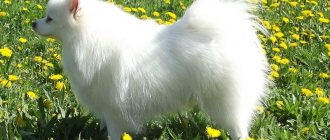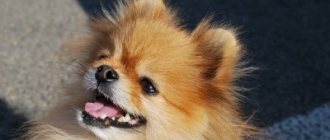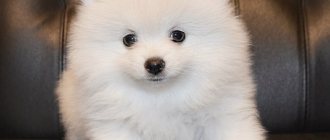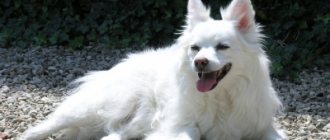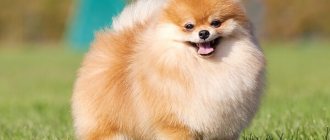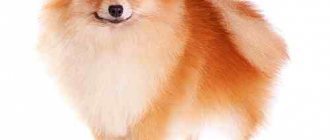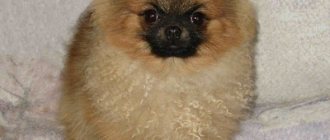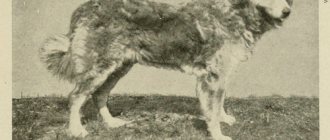One of the most recognizable features of Spitz dogs is their coat.
Dogs have luxurious fur around their chest and neck. Spitz dogs actually have a double coat with a tough outer coat and a soft undercoat. Owners of this breed must take care of their pet's coat, and it is recommended to brush it daily. This is due to the large thickness of the coat and constant shedding.
However, the Pomeranian's coat is easy to maintain and only takes a few minutes each day. Maintenance is important to prevent matting as this can lead to discomfort and health problems such as irritation of the underlying skin. Regular grooming will also maintain the quality of the coat and improve the appearance of your Pomeranian. It is also recommended to groom your dog every one to two months.
Photo: www.reddit.com
Spitz coats come in over 20 different color combinations.
Many dog breeds are available in three or five colors. But Spitz dogs boast 23 color combinations that are accepted by international kennel clubs. The most common colors are sable, chocolate, light red, brown, black, cream, blue and white. In addition to them, combinations of these colors are derived.
Many Pomeranian puppies change color over time as they grow older. For example, a cream-colored puppy may become brown and white, and a brown puppy may become bright red. It is impossible to determine in advance which puppies will change color as they grow older and which will not.
Character and education
Pomeranian Spitz training
The Pomeranian Spitz is naturally gifted with highly developed intelligence, which greatly facilitates the learning process (compared to other decorative dog breeds). However, a stubborn and independent character can become a serious obstacle to following commands. Forget about traditional training methods: in this case they do not work. You will have to find a special approach to your pet.
The main thing in raising a Pomeranian is to forget about its touching appearance. Often, the owners of these dogs treat them like children, considering their pets small and not yet capable of carrying out complex commands. The Pomeranian Spitz needs a confident owner who can show strength of character and has leadership qualities.
We invite you to read: Stories of fox hunting in winter
In general, dog breeders characterize the Pomeranian Spitz as a smart creature that is easy to train with the right approach to training. The only thing that may cause problems is toilet training. Due to the peculiarities of the Pomeranian’s structure, it is difficult for the Pomeranian to retain the contents of its bladder for a long enough time, so the dog can relieve itself right in the apartment.
Spitz and children
As soon as the puppy gets into the house, you need to immediately begin raising it properly. The first step is to allow what is possible and prohibit what is not.
You should always praise your pet for its obedience and scold it if it misbehaves. The Pomeranian is very smart and picks up everything on the fly, so you don’t need to yell at him. But you shouldn’t give any concessions either - the Spitz will quickly understand that he can achieve whatever he wants.
It is very important to pay attention to your pet, communicate and play with it. Otherwise, there is a risk that an insecure and aggressive dog will grow up.
When you get a Pomeranian, you won’t have to change your habits - he loves to please his owner, so there won’t be any special problems with training. From as early as five months, the dog can learn basic commands.
Tell us what your Pomeranian looks and behaves like? How old is he?
Spitz dogs once pulled sleighs and herded reindeer
A healthy adult Spitz usually weighs 3-5 kg and measures between 18 and 30 cm at the withers, but this breed originated from large sled dogs. Hard to believe, right?
The ancestors of modern Spitz could weigh from 9 to 14 kg. They are originally from Northern Europe. They were used to tow sleighs and reindeer. Scientists have traced their ancestry to large working dogs from the Arctic regions called Wolfspitz. Spitz dogs turned out to be close relatives of such breeds as the American Eskimo dog, Alaskan Malamute, Norwegian Elkhound, Siberian Husky and Samoyed Laika.
Photo: Nick Fewings
Spitz means “sharp tip” in German. This term was first introduced in the 16th century by Count Eberhard zu Sayn. For many decades, efforts have been made to gradually reduce the size of the Spitz. But even today, sometimes Spitz dogs are born that are very similar to their ancestors. This dog has a pure white color that does not change as it matures.
Queen Victoria made Pomeranians popular
Until 1888, the breed was little known. This year, Queen Victoria traveled to Italy, where she was given a Spitz named Marco. Since the 18th century, many members of the royal family began keeping Spitz dogs as pets, which increased their popularity both in Britain and abroad. During Queen Victoria's lifetime, the size of the breed was halved due to crossbreeding with other breeds.
Queen Victoria isn't the only famous person to fall in love with adorable Pomeranians. Isaac Newton, Martin Luther, Michelangelo and Mozart all had Pomeranians. Mozart dedicated one of his arias to his beloved dog Pimperl. Legend has it that Chopin's Waltz of the Dog was written after a visit to a friend's house where he saw a Pomeranian dog happily chasing its tail.
Origin story
The history of the Pomeranian Spitz originates on the Baltic coast, in the northern region of Germany - Pomerania. Interestingly, this is where the name of the dog species spread. But initially the breed called Spitz was not miniature: the ancestors of today's animals weighed about 10–12 kg.
At the beginning of the 19th century, Queen Victoria visited Pomerania. She liked the Spitz dog so much that soon a similar variety began to be bred in England. Now the dogs have become miniature, and their skin has been significantly improved. These dogs appeared in the vastness of America already at the end of the 19th century. From that moment on, they were often demonstrated at various exhibitions, and the Spitz as a full-fledged dog breed became widely known in the country and far beyond its borders.
Spitz are excellent companion dogs
They are smart, mischievous, curious, daring and brave. Spitz dogs are loyal companions who fiercely protect their owners. They are an ideal choice for those looking for a small pet, a canine companion, rather than a property protection guard dog. Although the Spitz is ready to rush at a stranger at any moment with a ringing bark, warning the owners of a possible threat.
Spitz dogs are usually very playful and love to be the center of attention. They make great pets, but may not be the best choice for those with small children. Although Pomeranians look like little living toys, they do not make good playmates for children, who may accidentally step on them or handle them too roughly.
Photo: www.dogster.com
Spitz dogs can make excellent therapy dogs. But keep in mind that these dogs are very active and love to bark. Giving them chew toys will help tame their energy and calm them down.
Care and maintenance
Wool is the main asset of a fluffy Spitz, so it should receive a lot of attention from the owner.
The pet's fur coat is regularly combed. It is especially important to do this during seasonal molting - it is combed out until it is completely renewed. A short haircut could make life easier for the owners of the animal, but doing this is strictly prohibited - the dog may catch a cold. Thick, dense wool is a natural heat regulator and protection against sudden temperature changes. Only show dogs need special grooming - it is done in salons immediately before the show. They bathe dogs if necessary, and do this without fail before shows. Spitz wool is very thick, it does not get wet easily and dries very slowly. A fur coat that is not completely dried can cause a cold even in summer. After water procedures, the dogs are thoroughly dried, carefully blotting with a towel. You cannot rub the wool intensively, as this will electrify it, which will contribute to the appearance of new tangles. You need to dry it with a hairdryer until completely dry.
The breed's ears stand up well and do not require special care. All that is required is a weekly inspection and gentle cleaning with a cotton swab dipped in boiled water or chamomile decoction. Dirt from the corners of the eyes can also be cleaned with a damp swab.
The anal glands require special care; they must be regularly cleaned of accumulated secretions. Especially those dogs that are kept at home and rarely go outside. Because of this, the glands can become inflamed. Small representatives of the breed are most often susceptible to this problem.
German Spitz teeth are cleaned with a special brush and tooth powder or toothpaste. Sticks and bones for dogs, which are sold in pet stores, are good for removing plaque from teeth. Large beef bones are suitable for the same purpose - give them raw to dogs.
When keeping a pet at home, it is necessary to allocate its own place with a comfortable bed. It is advisable to organize it somewhere out of sight of everyone - dogs love to be alone. A distinctive feature of the breed is that puppies of clean Spitz dogs are no worse than cats in learning to go to the toilet in a tray. The main thing is not to shame or scold children during the training process. Use affection and praise for this - the dogs will quickly understand what you want from them.
They rarely have health problems
They are a robust dog breed, which means that Pomeranians do not suffer from many of the diseases that are common in smaller breeds. However, they may experience some health problems.
Alopecia X is the most common condition among Spitz dogs. This genetic disorder, called black skin disease, causes darkening of the skin and hair loss. A Spitz can also go bald due to hormonal imbalances.
Spitz dogs often suffer from a dislocated kneecap. The ridges that form the patella are too small, so they can “jump” out of the joint with sudden movement or injury.
Tracheal collapse occurs when the tracheal rings are weakened. This leads to blockage of the airways. Tracheal collapse becomes more common as the dog gets older. Common symptoms include coughing and fainting.
Pomeranians are very similar to German Spitzes
So much so that sometimes inexperienced breeders cannot distinguish one from the other. Sometimes even the owners themselves do not know who lives in their home. The German Spitz has an elongated muzzle and a coarser coat. Crosses between these two breeds are allowed, but then the puppies are considered German. If you want to purchase a purebred orange, be sure to contact a nursery with a good reputation and check out the pedigree of the babies.
Non-purebred babies will not meet the breed standard
They don't need regular training
Photo: www.germanspitzlove.com
One of the possible reasons for the popularity of this breed is that Pomeranians do not need to actively exercise. Therefore, such canine companions are of interest to busy people who do not have time to regularly exercise their dogs, or those who live in city apartments and have limited access to open spaces for exercising their dogs. It is also an attractive breed for those who have mobility issues.
Recommendations for this breed in terms of exercise include daily short walks outside or active running around the house/apartment. You need to make sure that energetic Pomeranians get enough activity to stay healthy.
Advantages and disadvantages
Like any other breed, the Spitz has its advantages and disadvantages. Before adopting a puppy, you should evaluate the complexity of its maintenance and the characteristics of its upbringing.
pros
- activity, cheerfulness and energy, if you want to have not just a dog, but a companion who would accompany you on walks and vacations, then this is your option,
- devotion and affection, representatives of this breed quickly get used to the owner and all family members, he will try with all his might to please you,
- good ability to train, this is an understanding and smart dog , it learns commands quite quickly,
- cleanliness, the orange licks itself, so it does not need water treatments often, in addition, the animal does not smell like a dog at all,
- accommodating, the dog gets along well with other pets, especially if you introduce it to other four-legged friends from an early age.
Minuses
- loud barking, if you don’t train your Pomeranian, then the loud yapping in your house will be almost continuous,
- shedding - Spitz shed a lot, so the room where they live requires constant wet cleaning,
- the need for education, such a dog requires a firm hand that can teach him commands and make him obedient, the breed’s character trait is a tendency to dominate , which is why the Pomeranian needs to be immediately explained who is boss in the house,
- Poor tolerance of loneliness. If the owner is not around for a long time, the dog begins to get bored.
Spitz live long, but produce small litters
The Spitz stands out from other breeds because it is a dog of extremes. On the one hand, it has one of the longest lives of any dog breed, as it can live for about 16 years. On the other hand, Spitzes have a much smaller litter than most dog breeds. Typically, one Pomeranian litter produces two to three puppies. Some even produce only one puppy at a time. This means that the Pomeranian is one of the least profitable breeding options for breeders.
Photo: buddyboowaggytails
The Pomeranian is not the only Spitz
There are several varieties of Spitz. The largest is the Wolfspitz. Its height reaches 55 cm. It is 3-4 times taller than the Pomeranian Spitz! The Grossspitz is slightly smaller: its height is approximately 45–50 cm. There are also medium, small and miniature Spitz.
Some of the fans of the breed are Kristen Steward from “Twilight”, tennis player Maria Sharapova, Yulia Nachalova and Sharon Osbourne, Nicole Richie and Eva Longoria
